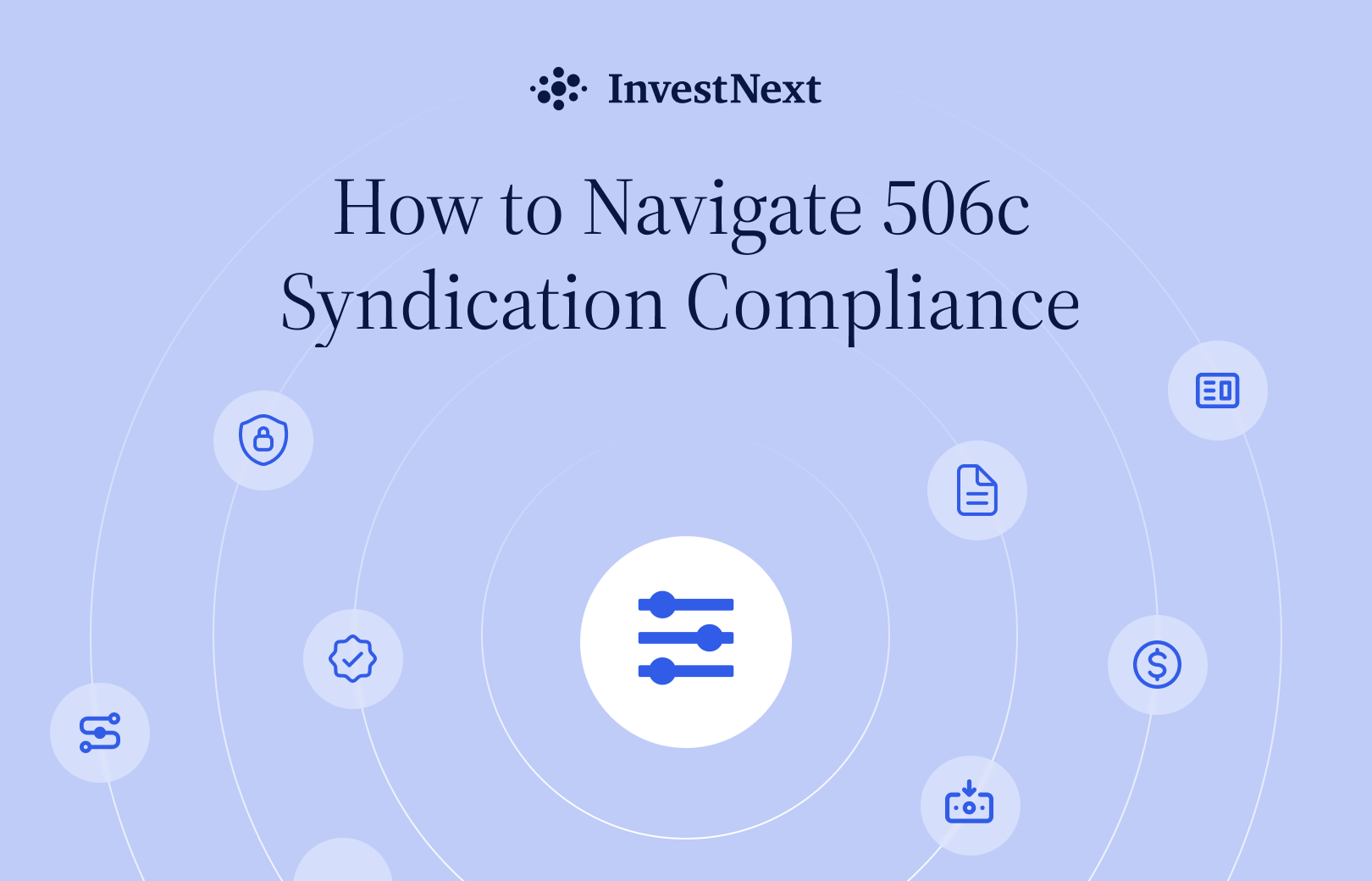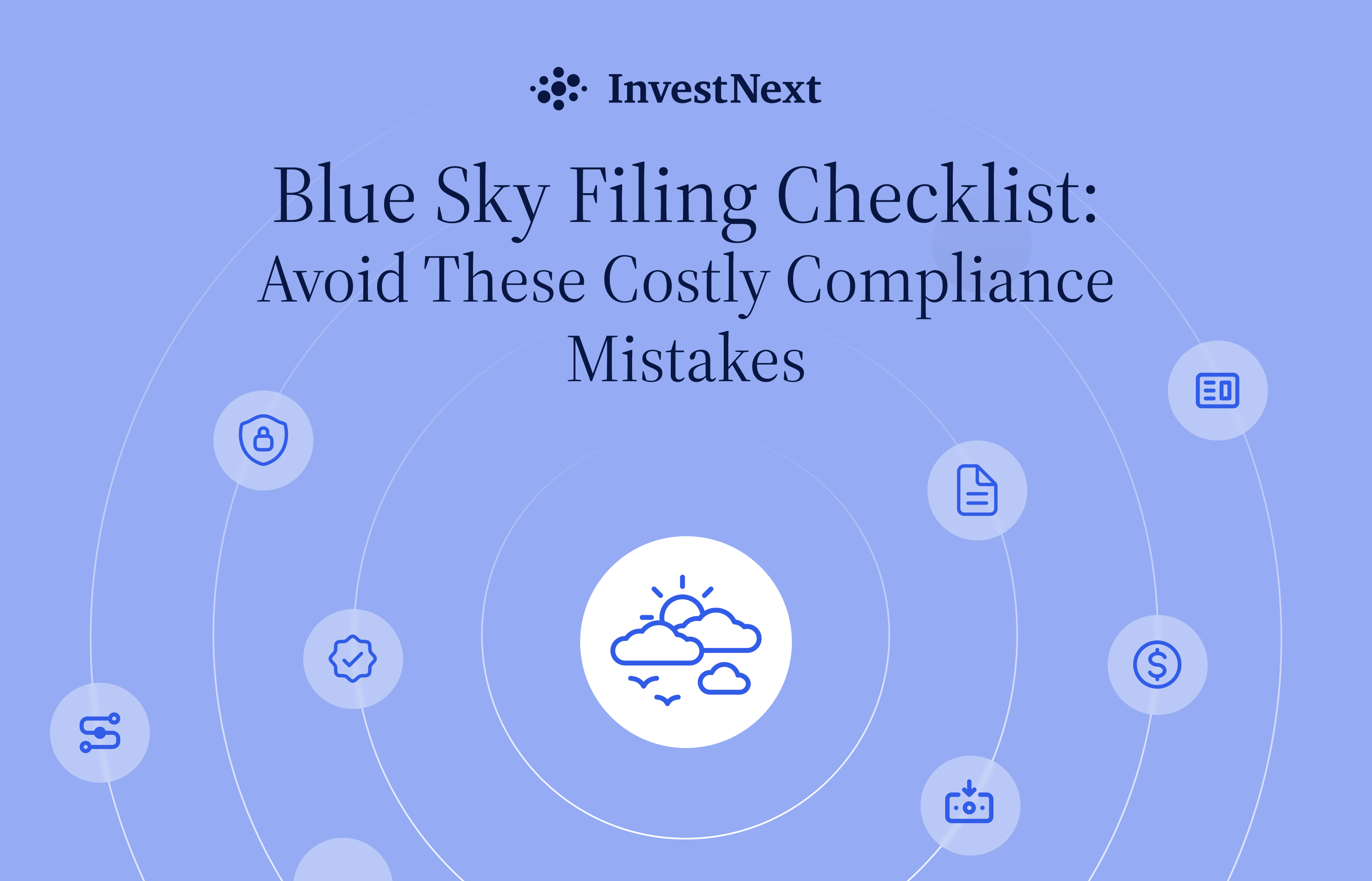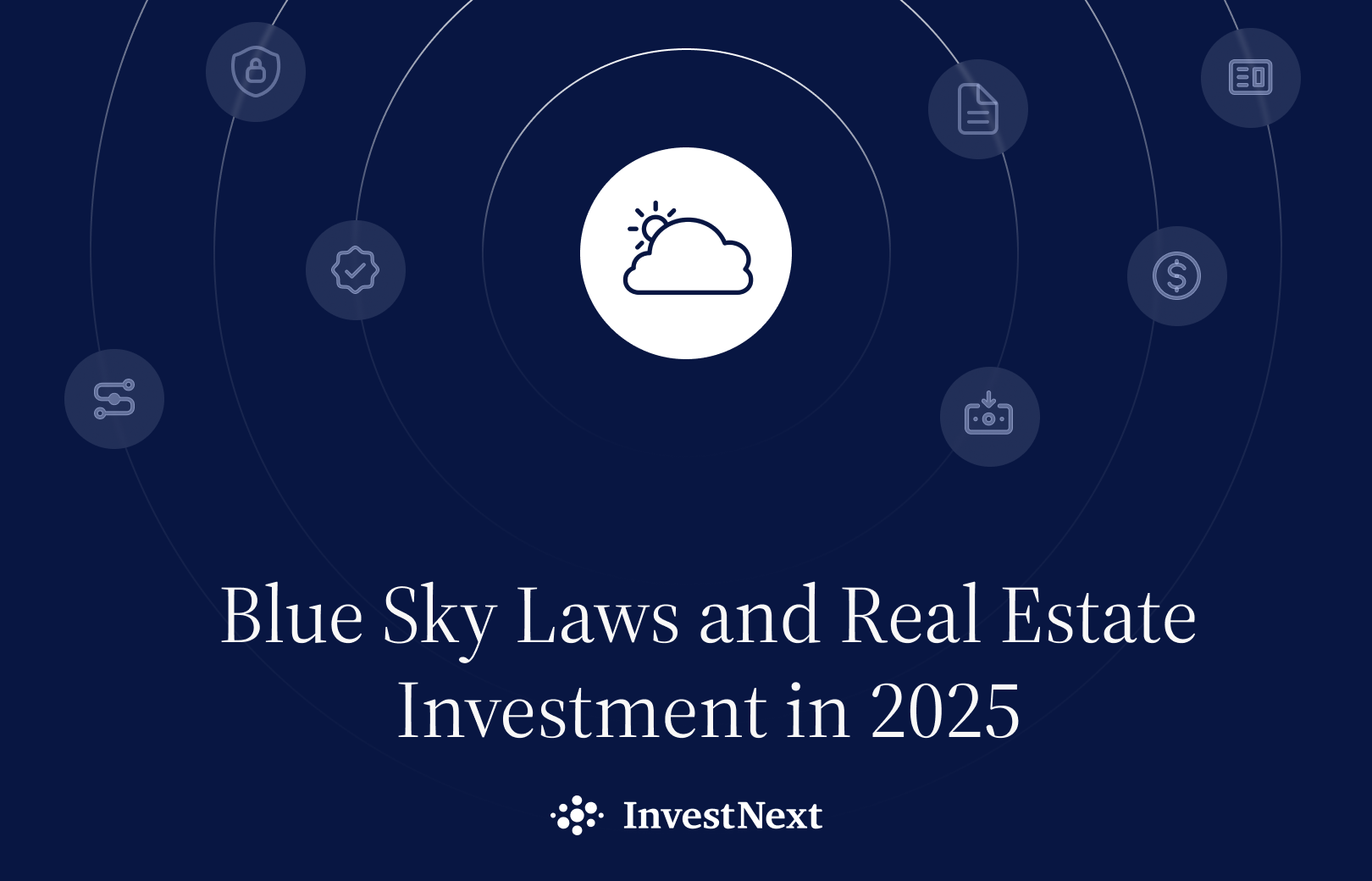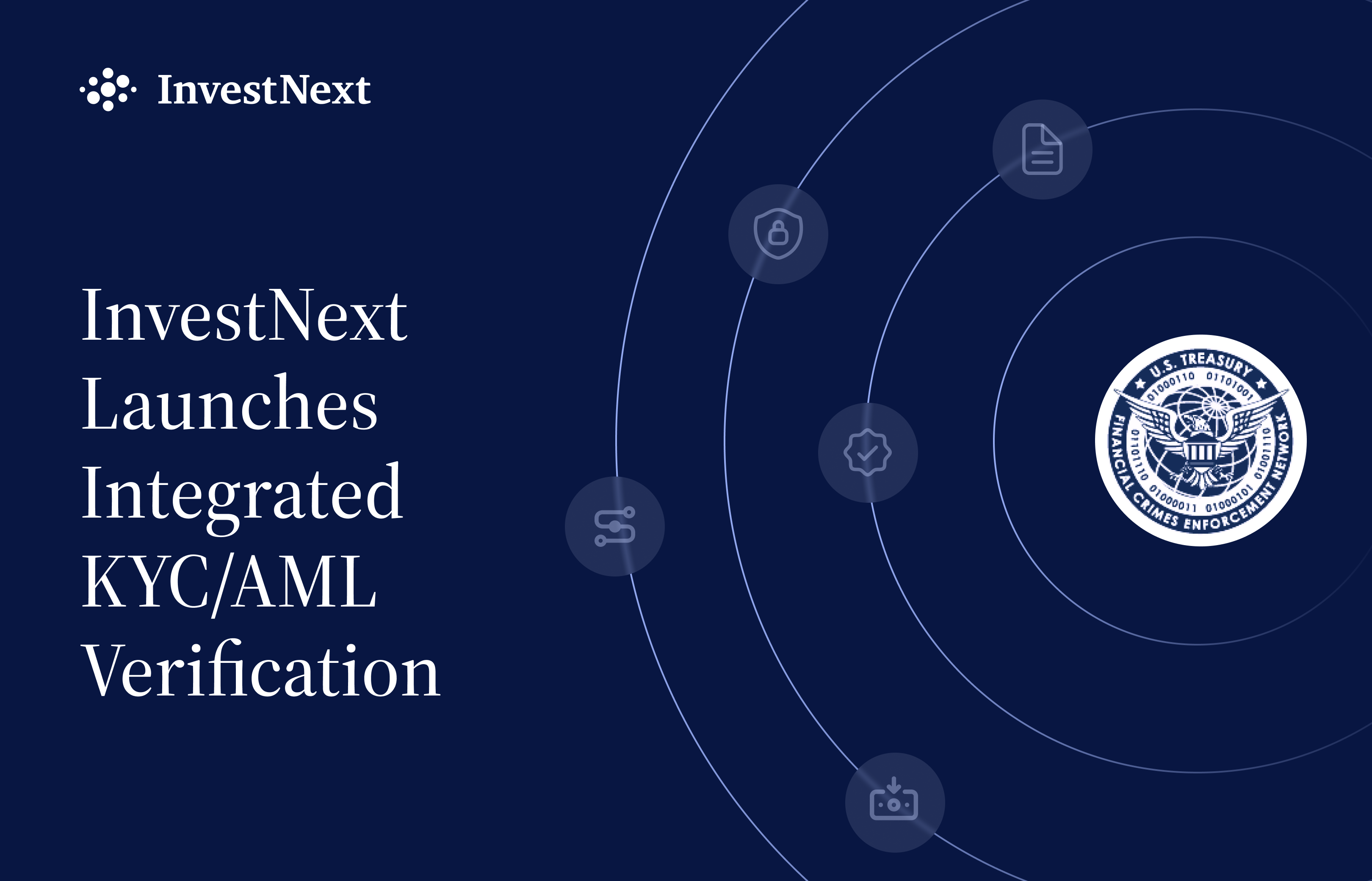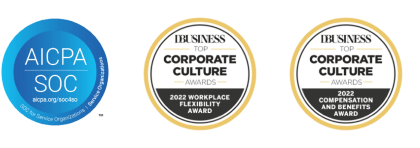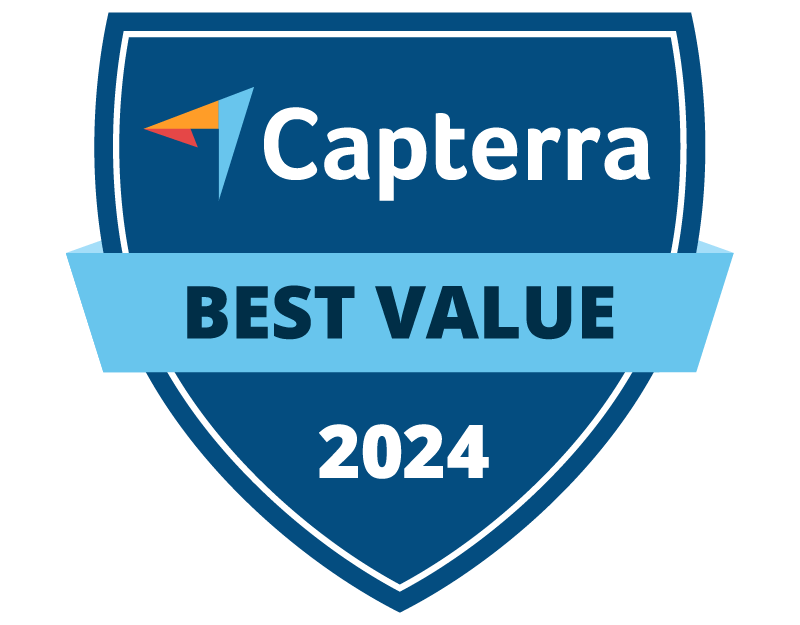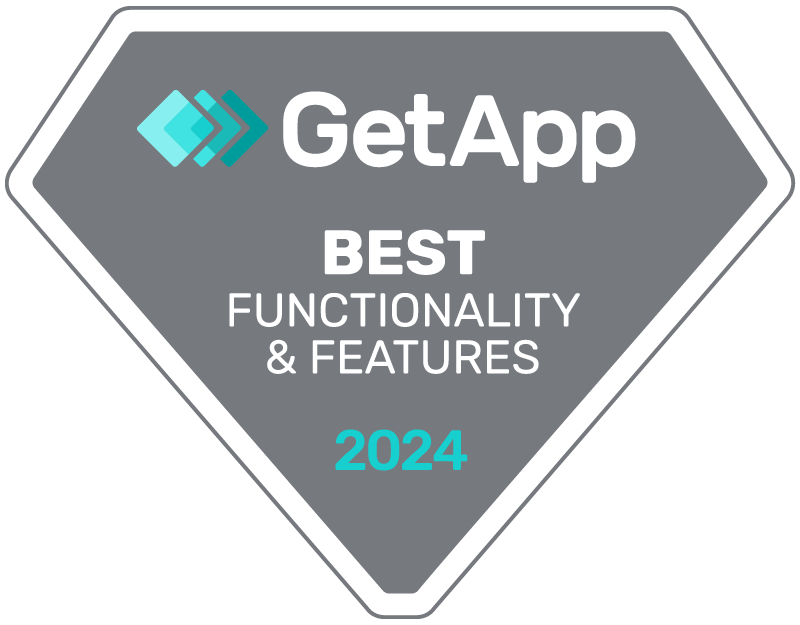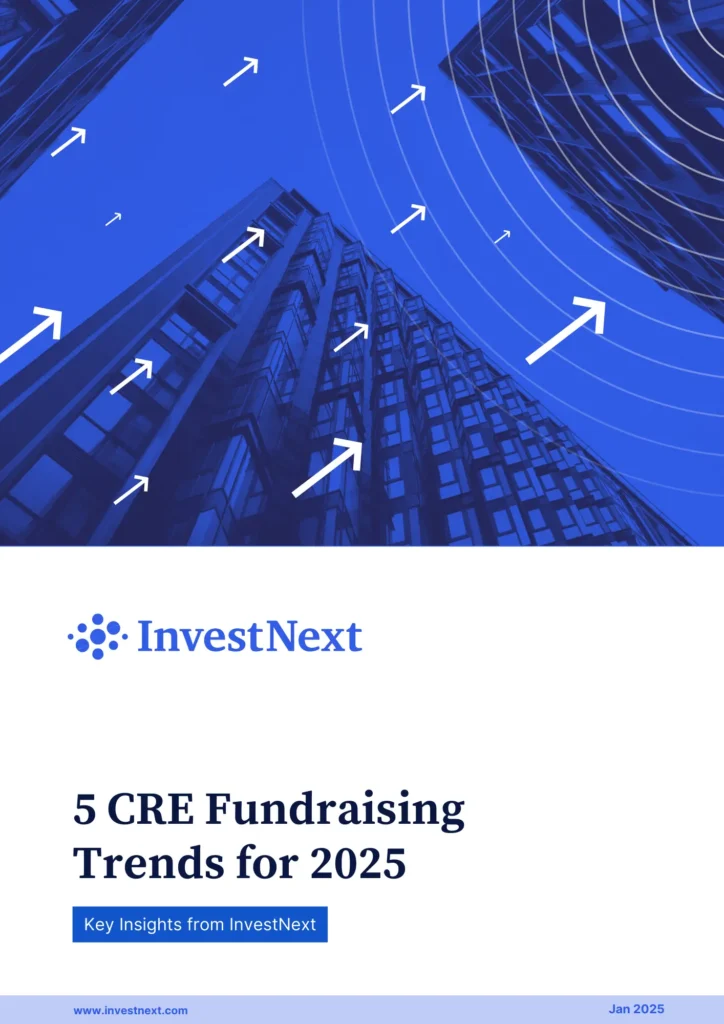Disclaimer: This article is for informational purposes only and does not constitute legal advice. All firms raising capital should consult legal counsel with expertise in real estate compliance and SEC regulations.
506(c) offerings stand at the forefront of modern real estate capital raising, enabling investment firms to tap into public solicitation channels with unprecedented reach.
Real estate investment firms face distinct compliance hurdles when structuring 506(c) syndications. The expanded fundraising capabilities of 506(c) offerings unlock significant advantages over traditional 506(b) structures.
However, these opportunities come paired with stringent accredited investor verification requirements and detailed SEC compliance protocols. Success hinges on mastering two core elements: proper investor verification procedures and precise marketing guidelines.
This practical guide equips you with proven strategies for 506(c) compliance excellence. From building robust verification systems to executing SEC filings with precision, each section delivers actionable insights for your investment operations.
The InvestNext platform amplifies these strategies through purpose-built technology, enabling your firm to scale while maintaining impeccable compliance standards. Whether you’re launching your initial 506(c) fund or enhancing existing procedures, you’ll gain the tools needed to execute with confidence and precision.
Understanding 506(c) Fundamentals
Rule 506(c), established through the JOBS Act in 2013, marks a pivotal advancement for real estate capital formation. Smart investment strategies start with mastering these essential components.
Key differences from 506(b) offerings
506(c) offerings create a distinct path for investor qualification and marketing outreach.
The structure permits general solicitation of investment opportunities, which includes not only public advertising but also discussing private offerings with potential investors you’ve just met, such as at conferences or networking events.
This powerful advantage requires heightened diligence – firms must exclusively work with accredited investors and implement thorough verification protocols.
Clear distinctions emerge in these key areas:
| Aspect | 506(c) | 506(b) |
| Advertising | Permitted | Not Allowed |
| Investor Type | Accredited Only | Accredited + Up to 35 Non-accredited |
| Verification | Strict Documentation | Self-certification |
Benefits of choosing 506(c)
506(c) structures deliver strategic value through four key advantages:
- Market Expansion: Direct advertising channels multiply your accredited investor reach
- Unlimited Capital Potential: Remove restrictions on raise amounts and accredited investor numbers
- Federal Preemption: NSMIA provides exemption from state securities regulations
- Marketing Authority: Full access to modern digital communication tools
Common compliance challenges
Success with 506(c) demands precise attention to compliance protocols. Your verification system must capture complete documentation of accredited status – whether through tax returns, financial statements, or professional certifications.
Maintain meticulous verification records and updates, meeting SEC requirements for “reasonable steps” at each investment point. Your compliance calendar must track Form D submissions within 15 days of initial sales. Marketing materials require careful alignment with SEC guidelines to maintain full compliance.
Implementing Investor Verification Systems
Strong investor verification systems power successful 506(c) syndications. SEC guidelines mandate “reasonable steps” for accredited investor verification, placing this process at the heart of your compliance framework.
Digital verification solutions
Smart technology platforms elevate the verification experience. Digital solutions cut document processing time while boosting accuracy rates. These tools create audit-ready records, giving your team instant access to critical compliance documentation.
Documentation requirements
Precise documentation validates accredited investor status through multiple qualification paths. Your verification toolkit must include:
| Verification Method | Required Documentation |
| Income-Based | Tax returns (past 2 years), Written income expectation statement |
| Net Worth | Bank statements, Brokerage statements, Asset documentation |
| Professional | Verification letters from attorneys, CPAs, or registered advisors |
| Entity Status | Incorporation documentation, Financial statements |
Quality standards demand documentation within three months of verification. Your records must show clear evidence of thorough verification procedures.
Verification timeline management
Recent SEC guidance establishes a five-year verification window for returning investors. Previous verification allows written confirmation for future investments within this timeframe, provided no contradicting information exists.
Excellence in timeline management requires:
- Active expiration date tracking
- Structured review cycles
- Strong investor communication protocols
- Complete verification documentation
Secure verification precedes capital acceptance. Mixing 506(b) and 506(c) methods within offerings creates compliance risks. Your documented procedures demonstrate regulatory adherence and protect your firm’s interests.
Navigating Marketing Compliance
506(c) syndication opens powerful marketing channels for real estate investment firms. Rule 506(c) grants broad advertising authority while demanding precise adherence to specific protocols.
Permitted advertising channels
506(c) funds connect with accreditted investors through diverse media channels. Approved platforms include:
- Custom investment websites
- Digital advertising networks
- Strategic email outreach
- Industry publications
- Educational seminars
- Broadcast media opportunities
Content guidelines and restrictions
Marketing excellence demands unwavering accuracy and transparency. Follow these essential standards:
| Content Element | Requirement |
| Securities Disclosures | Include comprehensive risk information |
| Return Statements | Avoid guarantees or misleading claims |
| Investment Terms | Present clear, accurate representations |
| Risk Factors | Provide balanced, thorough disclosure |
Marketing materials must avoid phrases like “guaranteed returns” or “risk-free.” Your message should reflect precise investment terms and strategies, eliminating ambiguity or overstatement.
Risk mitigation strategies
Smart protection measures enhance marketing success while maintaining compliance:
- Documentation Control: Build complete records of marketing assets and distribution data. InvestNext delivers purpose-built tools for tracking and archiving all communications.
- Review Process: Secure legal review for advertisements, social content, and presentation materials before release. This validation strengthens regulatory alignment and protects firm interests.
- Compliance Monitoring: InvestNext’s advanced compliance tools create audit trails for marketing activities and verification procedures. This structured approach validates your due diligence under regulatory scrutiny.
While 506(c) enables broad marketing reach, all materials must meet SEC guidelines with proper disclaimers. Precise documentation and adherence to these standards empower confident marketing execution with minimal risk exposure.
Streamlining SEC Filing Requirements
SEC filing protocols establish the regulatory foundation for 506(c) syndication success. Precise management of these requirements safeguards your offering while optimizing operational performance.
Form D submission process
506(c) offerings demand Form D submission to the SEC within 15 days of initial sale. Your EDGAR system filing must detail:
- Principal business information
- Capital raise targets
- Offering specifications
- Security structures
Strategic advantage: InvestNext’s advanced platform automates filing deadline tracking, creating bulletproof documentation protocols.
Ongoing compliance obligations
Your regulatory duties continue past Form D submission. Key requirements include:
| Requirement | Timeline |
| State Notice Filings | Within 15 days of first sale in each state |
| Material Changes | File amendments as needed |
| Annual Updates | Renew state filings where required |
InvestNext’s sophisticated monitoring system tracks multi-jurisdictional obligations, eliminating compliance gaps and missed deadlines.
Record keeping best practices
Excellence in 506(c) compliance demands meticulous documentation. Your records architecture must capture:
- Investor Communications: Full interaction histories and disclosure logs
- Distribution Records: Precise financial transaction data
- Tax Reporting: Structured documentation systems
- Verification Process: Detailed accreditation verification records
InvestNext’s purpose-built platform delivers enterprise-grade document management. Smart automation streamlines collection, organization, and storage workflows, boosting accuracy while reducing administrative load.
Form D submissions operate independently of SEC review or approval. However, pristine records demonstrate your commitment to securities regulation compliance. InvestNext’s advanced toolset handles these requirements with precision, freeing your focus for portfolio growth.
Leveraging Technology for Compliance
Smart technology platforms define modern 506(c) syndication excellence. Purpose-built digital solutions create unmatched efficiency while upholding strict compliance standards.
Automated verification workflows
InvestNext slashes verification timelines by 90% through intelligent automation. The platform powers your accreditation protocols with:
- Flexibility to request accreditation verification on demand or directly within the commitment flow
- Ability for investors to obtain a new accreditation letter directly inside the platform
- Intuitive investor flow to minimize investor attestation errors
- Bank-grade security
Two-way email synchronization enables fluid investor dialogue within SEC guidelines. These automated workflows turn complex verification tasks into streamlined processes, accelerating deal momentum.
Compliance monitoring tools
506(c) success demands vigilant oversight. InvestNext delivers enterprise-grade monitoring capabilities:
| Compliance Feature | Benefit |
| Real-time tracking | Monitor verification status |
| Document management | Centralize compliance records |
| Automated alerts | Stay current with deadlines |
| Audit trail | Track all verification steps |
Built-in CRM capabilities strengthen investor relationships while maintaining SEC alignment. Custom workflows scale with your business growth, creating sustainable compliance frameworks.
Integration with existing systems
- InvestNext amplifies your current tech stack through strategic integrations.
- Streamlined Operations: Zapier integration enables code-free automation setup, connecting seamlessly with existing tools and processes.
- Enhanced Investor Experience: Professional-grade investor portals build confidence and facilitate smooth transactions, creating unified experiences for teams and investors.
- Automated Distributions: Smart distribution tools optimize payment workflows, ensuring precise, timely investor payments with minimal oversight.
InvestNext’s technology creates scalable 506(c) syndication operations. The unified platform centralizes investor data management, enabling role-based access across teams. This strategic approach strengthens both operational capability and compliance precision.
SEC-compliant architecture ensures regulatory alignment while delivering modern automation advantages. Purpose-built features empower real estate syndicators to focus on portfolio growth while maintaining impeccable compliance standards.
Conclusion
506(c) syndication creates exceptional capital raising potential for real estate investment firms. This guide equips you with proven strategies for investor verification excellence, marketing precision, and SEC filing mastery.
Excellence in 506(c) offerings stems from disciplined execution. Rigorous verification protocols validate investor accreditation. Strategic marketing oversight ensures regulatory alignment. Precise SEC filings demand exacting attention to deadlines and documentation.
InvestNext’s advanced platform powers these essential functions through smart automation, unified compliance tools, and secure document control.
These capabilities deliver peak compliance performance while reducing operational complexity. Schedule a demo today to unlock your firm’s capital raising potential.
Modern real estate syndication demands both compliance expertise and technological efficiency. With the right tools and knowledge, firms can confidently scale their operations while maintaining the highest standards of regulatory compliance.
Armed with strategic knowledge and purpose-built tools, your firm stands ready to scale investment operations within the 506(c) framework.
FAQs
What is the main difference between 506(b) and 506(c) offerings in real estate syndication?
The key difference is that 506(c) offerings allow public advertising of investment opportunities, while 506(b) offerings do not. However, 506(c) offerings can only accept accredited investors and require stricter verification of investor status.
How can real estate syndicators verify accredited investor status for 506(c) offerings?
Syndicators must take reasonable steps to verify accredited investor status, which can include reviewing tax returns, bank statements, or obtaining verification from qualified professionals like attorneys or CPAs. Digital verification solutions can streamline this process.
What marketing channels are permitted for 506(c) real estate syndications?
506(c) offerings can be marketed through various channels, including public websites, social media, email campaigns, print media, public seminars, and even television or radio appearances. However, all marketing materials must comply with SEC guidelines.
What are the SEC filing requirements for a 506(c) real estate syndication?
Syndicators must file Form D with the SEC within 15 days of the first sale. They also need to submit state notice filings, file amendments for material changes, and potentially renew state filings annually where required.
How can technology help with 506(c) syndication compliance?
Technology platforms can automate investor verification workflows, provide compliance monitoring tools, and integrate with existing systems. These solutions can significantly reduce verification time, streamline document management, and help maintain SEC compliance throughout the syndication process.
